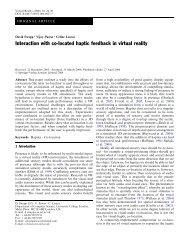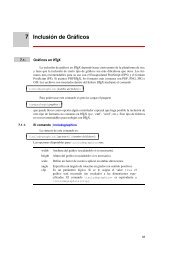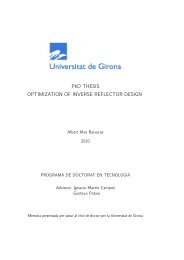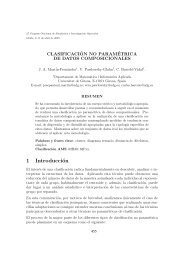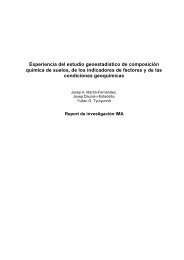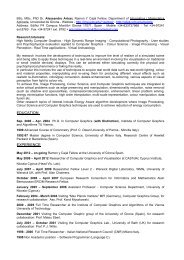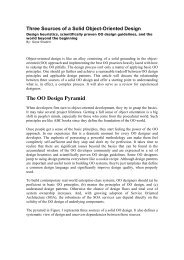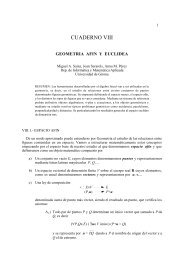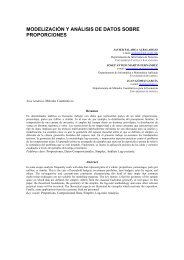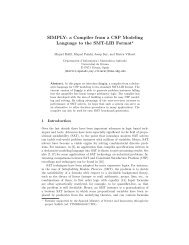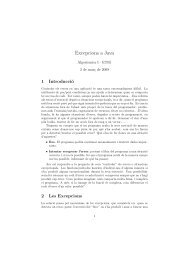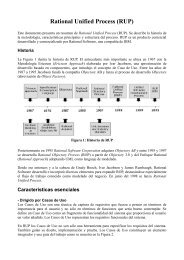Thomas, C.W. and Aitchison, J.
Thomas, C.W. and Aitchison, J.
Thomas, C.W. and Aitchison, J.
You also want an ePaper? Increase the reach of your titles
YUMPU automatically turns print PDFs into web optimized ePapers that Google loves.
3Binary logistic discrimination. For two types, such as the Duffinch <strong>and</strong> Inchrorylimestones here we may use binary logistic regression with logconstrasts of thecompositional components as the regressor; for a D-part composition x a logcontrastis defined aslc( α, x) = α log x1 + .. . + αDlog xD( α1 + .. . + αD= 0 ) .For two types (t = 0, t = 1) the binary logistic model is thus defined byexp{ α0+ lc( α , x)}pr( t = 0 | x) = 1 − pr( t = 1 | x)=1 + exp{ α + lc( α , x)}0.Maximum likelihood estimation of the parameter α is straightforward. The beauty ofthis model is that the adequacy of a subcomposition say (1, . . . , C) can readily betested since this hypothesis can be expressed as αC+ 1= . . . = αD= 0 . Thus the wholelattice of subcompositional hypotheses can be investigated <strong>and</strong> any adequatesubcomposition identified. Examples of this procedure can be found for hongitekongitediscrimination <strong>and</strong> Permian <strong>and</strong> post-Permian: discrimination in <strong>Aitchison</strong>(1986, Sections 12.6, 12.7).Figure 1 shows a portion of the substantial lattice of subcompositional hypotheseswith some of the more interesting subcompositions highlighted. The maximum modelat the top of the lattice retains the full 17-part composition as the explanatory variable.At the foot of the lattice is the hypothesis that compositional information is useless.At the next bottom level we have all the two-part subcompositions; at the next levelall the three-part subcompositions, <strong>and</strong> so on. In such lattice testing we usegeneralised likelihood ratio tests always testing the hypothesis within the maximummodel, starting with the simplest hypothesis, moving up the lattice to the next levelonly if we can reject all the hypotheses at the lower level <strong>and</strong> so on until we reach ahypothesis that we cannot reject. In the event that there are several non-rejectablehypotheses at a particular level that we either ‘accept’ the one with the smallestlikelihood ratio or move to the next level <strong>and</strong> ‘accept’ the hypothesis with the smallestlikelihood ratio. It should be remembered that in the absence of any loss structure in amultiple hypothesis situation all testing procedures are essentially ad hoc. We canonly report that we have found that this form of lattice testing usually leads to sensibleinferences.The dramatic result for limestones was reported in <strong>Thomas</strong> <strong>and</strong> <strong>Aitchison</strong> (1998),where out of the 17-part geochemical composition a 3-part subcomposition, namely(Fe, Mg, Ca), is found to be an adequate discriminator. The separation of the duffinch<strong>and</strong> inchrory limestones on the basis of the (Fe, Mg, Ca) subcomposition wasillustrated in a logratio scattergram, namely a (log(Fe/Ca), log(Mg/Ca)) plot. Weshow in Figure 2a the ternary diagram of the (Fe, Mg, Ca) subcompositions. Becauseof the smallness of Fe <strong>and</strong> Mg relative to Ca the subcompositional points crowd intothe Ca corner of the ternary diagram providing little illumination of the differences inthe duffinch <strong>and</strong> inchrory subcompositions. We can, however, use the device of acentering perturbation *von Eynatten, Pawlowsky-Glahn <strong>and</strong> Mateu Figueras, 2002)to provide a clearer picture of the separation. This is shown in Figure 2b, together



